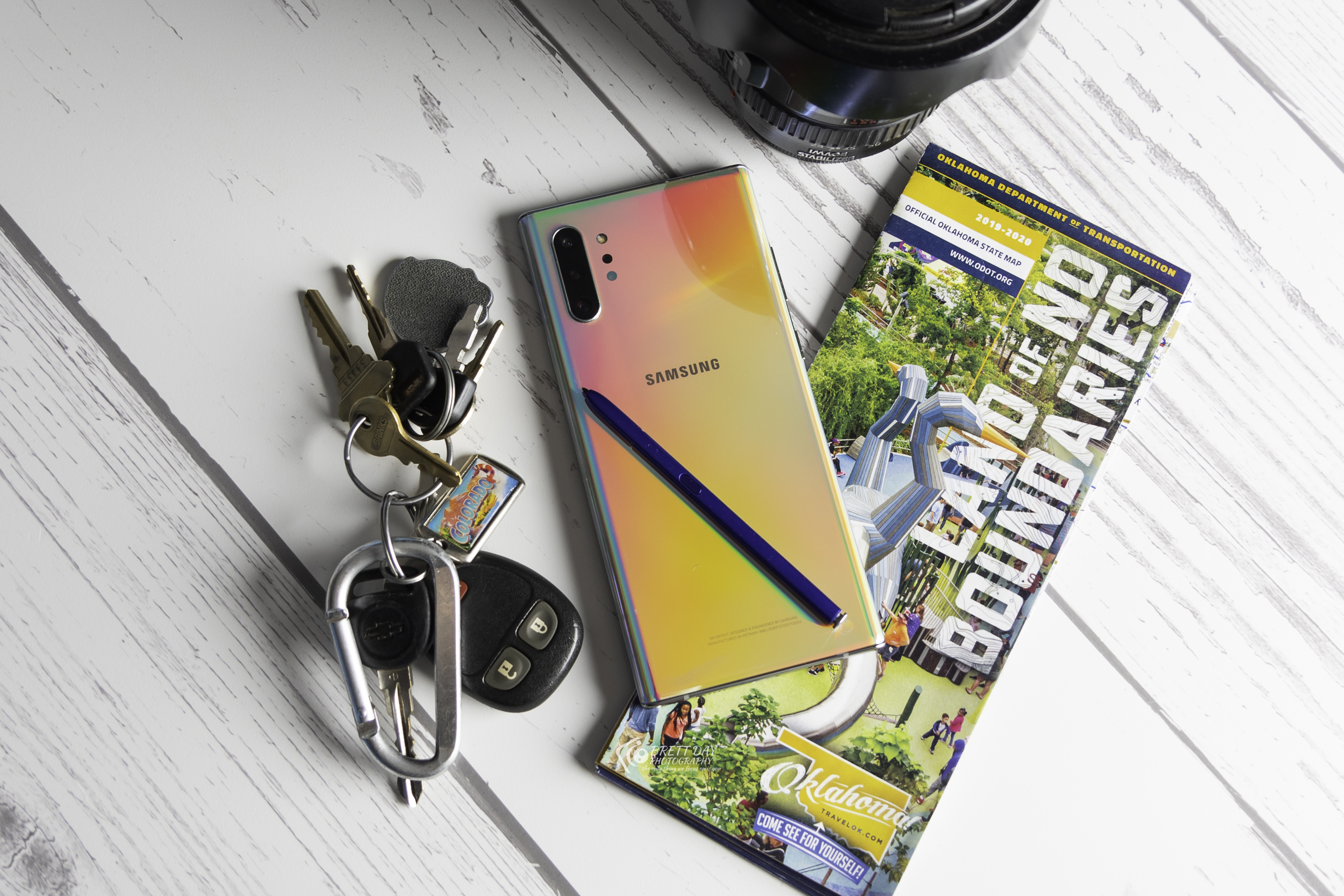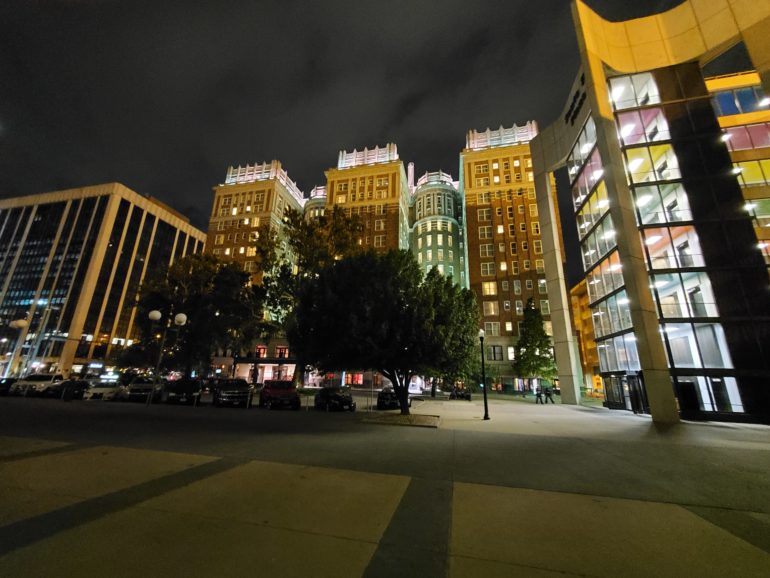Last Updated on 12/21/2019 by Mark Beckenbach
The Samsung Galaxy Note 10+ continues to blur the lines between phones with cameras and dedicated cameras.
The Samsung Galaxy Note 10+ is packed with four cameras (three on the back and one on the front), and it promises to be quite extraordinary. We all have our own feelings about mobile photography, but whether you like it or not, it’s here to stay. Smartphone manufacturers have been working hard to blur the lines between dedicated cameras and those found in smartphones, and Samsung is no exception. Over the last few years, the Galaxy Note series of phones have been pushing mobile photography boundaries hard, and the AI they use is becoming more powerful. But do the cameras live up to the hype? Let’s find out in our review.
While we will cover specific aspects of the Note 10+ as a phone, we do have to note (pun absolutely intended) that this is primarily a review of the cameras and what they can do. I got to spend a good deal of time with the Samsung Galaxy Note 10+ before the review unit had to be sent back, and I came away quite impressed with what it could do. There’s no doubt that you can take some great pictures with this device, and it will mostly satisfy those who use it as their primary camera, but there’s still some way to go before these phones with cameras (or cameras with phones) can compete with dedicated cameras. With that said, Samsung and others are blurring the lines between the two as time goes by.
Table of Contents
Pros and Cons
Pros
- The image quality from the three cameras is quite impressive
- Pro Mode allows you to use the camera in manual mode
- You can shoot RAW from the primary camera when in Pro Mode
- Incredibly fast recharge times and excellent battery life
- The S Pen makes image editing quite fun
Cons
- The ultra-wide camera catches fingers in the corners
- The phone is quite difficult to hold due to the slick body
- Camera user interface is a little confusing
- The AI is hit or miss, especially when shooting portraits
- No removable battery
- Only one downward-facing speaker
Tech Specs
All technical specifications have been taken from the official Samsung website.
Galaxy Note 10+
Dimensions: 77.2 x 162.3 x 7.9 mm
Weight: 196 g
Battery: 4300mAh
Super Fast Charging 2.0 compatible with 45W Travel Adapter and 5A cable
Fast Wireless Charging 2.0
12GB RAM with 256GB internal storage
12GB RAM with 512GB internal storage
IP68
S Pen
Dimensions: 5.8 × 4.35 × 105.08 mm
Weight: 3.04 g
Bluetooth enabled
Lithium Titanate Battery: Up to 10 hours of battery standby time
Pressure levels: 4096
Pen tip diameter: 0.7 mm
IP68
Display
6.8″ Quad HD+ Dynamic AMOLED Infinity-O Display (3040×1440)
498 PPI (Pixels Per Inch)
HDR10+ certified
Front Camera
10MP Selfie Camera
Dual Pixel AF
Pixel size: 1.22μm
FOV: 80˚
F.No (aperture): F2.2
Live focus
Live focus video
Rear Cameras
16MP Ultra Wide Camera
Pixel size: 1.0μm
FOV: 123˚
F.No (aperture): F2.2
12MP Wide-angle Camera
SuperSpeed Dual Pixel AF, OIS
Pixel size: 1.4μm
FOV: 77˚
Dual Aperture: F1.5 mode/F2.4 mode
12MP Telephoto Camera
PDAF, OIS
Pixel size: 1.0μm
FOV: 45˚
F.No (aperture): F2.1
DepthVision Camera
VGA
Camera Modes
Food, Night, Panorama. Pro, Live focus, Photo
Video Recording
4K UHD video recording at 60 fps (3840×2160)
1080p FHD video recording at 60 fps (1920×1080)
720p HD video recording at 30 fps (1280×720)
Super Slow-mo 720p video support at 960 fps
Slow-motion 1080p video support at 240 fps
Ergonomics
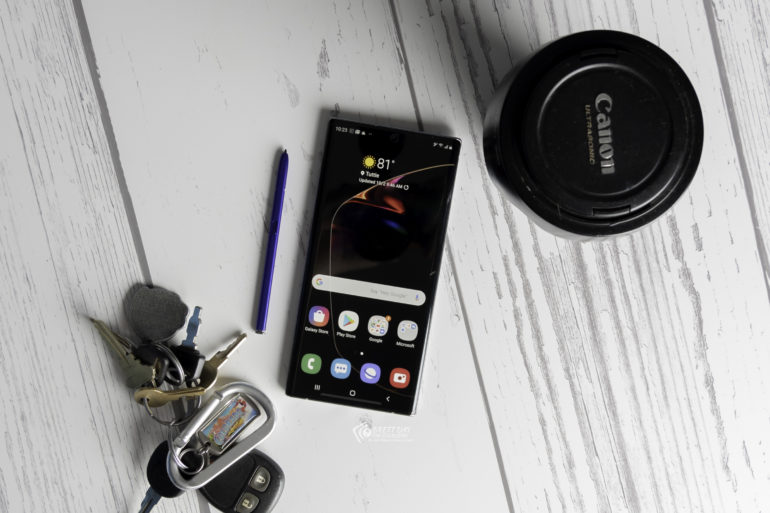
The Samsung Galaxy Note 10+ is a sizeable solid slab of glass that exudes class. Despite the phone featuring a 6.8-inch, edge-to-edge infinity display, the Samsung Galaxy Note 10+ is actually not that much bigger than other premium phones on the market. The screen, of course, takes center stage. It is simply gorgeous to look at while the phone features a minimalist design. The only other feature you’ll find on the front is the tiny front-facing camera, which is circular cut out at the top of the screen.

Flip the phone around to the left-hand side, and you’ll find the only two physical buttons on the phone. The volume rocker is well placed and is easy to access while holding the phone. The second button is the power button. You’ll also notice just how thin this phone is.
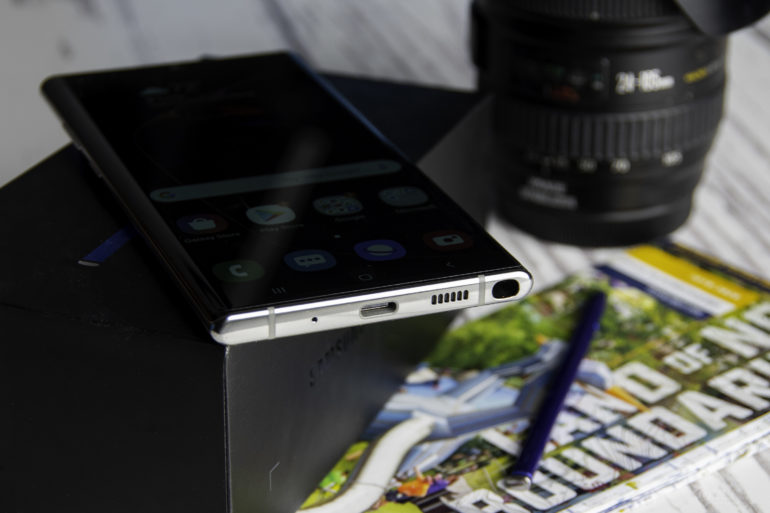
On the bottom of the phone, you’ll find the USB-C quick charge port, one down-firing speaker (why only one, Samsung?), a microphone, and the home for the S Pen. There are absolutely no controls on the right-hand side of the Note 10+. On top of the phone, the only thing you’ll find is the SIM tray.
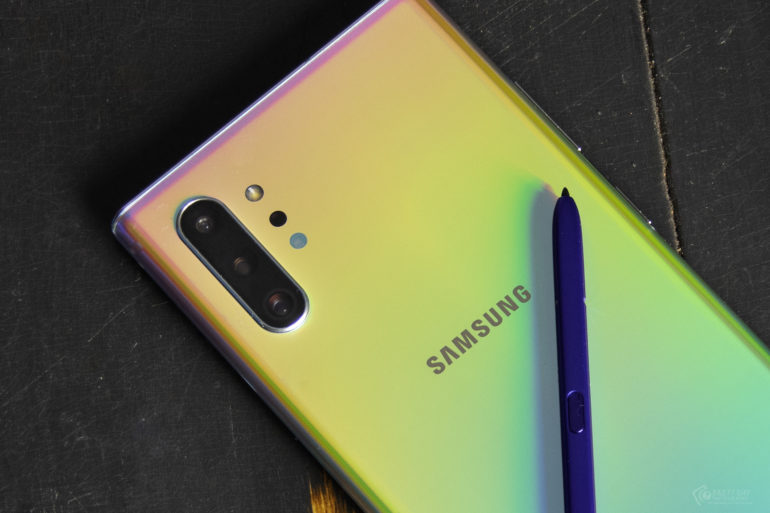
As mentioned above, the back is a solid slab of glass dominated by the four cameras. The main camera unit houses the ultra-wide, standard, and telephoto lenses, while the DepthVision cameras are to the right. They sit beneath the flash. Apart from the cameras, there is nothing else on the back except for the Samsung logo. That color, though. Aura Glow may not be to everyone’s liking, and it may be a fingerprint magnet, but I like it.
The Samsung Galaxy Note 10+ may be lovely to look at, and it does indeed feel like a premium device, but it’s difficult to hold. The surfaces are slick, and it’s so thin that you never feel like you’ve got reasonable control over it. The position of the ultra-wide camera (the top camera) causes issues while the phone is being held (more on that later). Overall, it’s a nicely designed phone that feels great in hand. Just exercise caution when holding it.
Build Quality

The Samsung Galaxy Note 10+ is about as premium of a phone as you will lay your hands on. The back of the device is like the front in that it is a solid slab of glass. I have to say this does concern me a little. I definitely would not use this phone without some sort of case as I’m sure a drop onto solid concrete or any hard surface would do some damage despite it being made of Corning Gorilla Glas 6. Crack the glass, and that will be an expensive repair. The S Pen feels as cheap as ever, which is a shame. The plastic body of the pen just doesn’t fit in with the rest of the device.
The Samsung Galaxy Note 10+ also has a dust and waterproof rating of IP68. The IP68 rating means that the phone can be submerged in 4.9 feet of water for roughly 30 minutes. It’s also protected against harmful dust. Overall the build is really nice, but for peace of mind you should use a case, even if only for a little extra grip.
Ease of Use
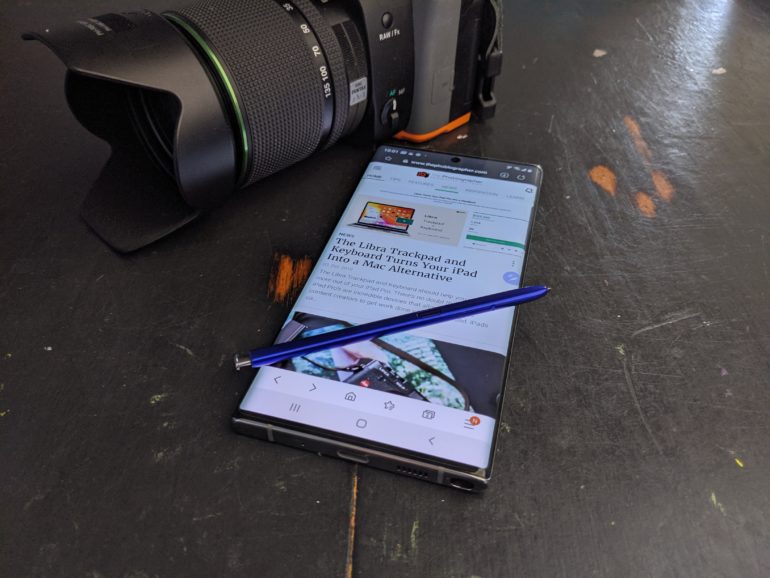
As a Daily Driver
If you’ve used an Android phone during the last couple of years, you’ll feel right at home with the Samsung Galaxy Note 10+. Once you get used to the size of the phone and learn how to hold it so that it is secure in your hands, you’ll have a pleasant time using it. The screen is gorgeous, and it makes viewing YouTube videos and browsing the web a delight. Samsung’s Android skin is a little on the cutesy side for me, but the icons are bright and large and make the phone easy to use. The screen is responsive: I never experienced any lag while using it. The S Pen is a nice feature too. It’s handy to jot down quick notes, and editing photo’s with it can be quite fun. But other than that I never really used it. If this is a feature you need, then you’ll love it; if not, stick to the Samsung Galaxy 10.
Two real downsides for me are; there is only one speaker, and there’s no removable battery. The speaker is loud enough, but it doesn’t sound very good. The battery is sealed in the device, and while this is a non-issue to some, to me it means an extra repair bill when your battery life begins to tank. Call quality is excellent, and the earpiece is loud and clear. As a daily driver, the Samsung Galaxy Note 10+ is an excellent phone to use.
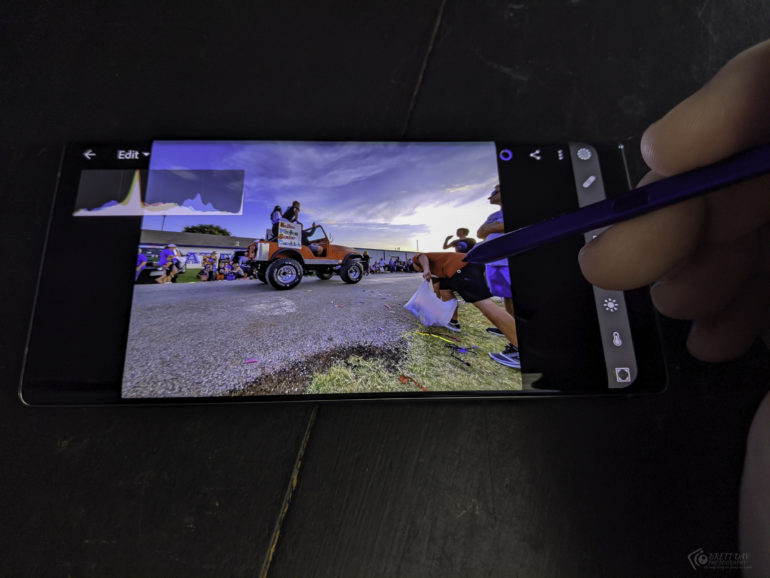
Customization
The Samsung Galaxy Note 10+ comes pre-installed with Android 9. Android is, of course, known for its customization. If there is anything you do not like about the phone, you can simply change it. Don’t like the Samsung launcher? Download Nova and design your own. Don’t like the notifications and ringtones? Grab Zedge and download your own. You can add widgets for quick glance information, and you can assign the power button to launch your favorite app. You can genuinely make the Samsung Galaxy Note 10+ yours, and you can make it work for you.
Battery Life and Charging
The battery life on the Samsung Galaxy Note 10+ is outstanding. You’ll easily get through the day with normal usage. Should you find yourself needing to charge the phone due to excessive picture taking, video making, or game playing, you’ll get a boost quick. The 4,300 mAh battery can be charged from 0% to 65% in about 30 minutes thanks to Samsung’s 25-watt rapid charger. In terms of battery life, while using the camera, I took about 100 photos during a local event that lasted over an hour and a half, and used roughly 15% of the battery life: not too shabby at all. There are all sorts of customizable power configurations that can extend the battery life at the expense of performance, but you really don’t need to worry about battery life in general.
Ease of Use as a Camera

Using the Samsung Galaxy Note 10 as a camera can be an enjoyable experience, but some flaws are introduced due to the design of the phone. I used the Note 10+ without a case, and I honestly did not feel comfortable holding the device because it is so slippery. It’s also so thin that it is hard to get a good purchase on the phone. You’re limited in the number of ways you can hold the device due to the infinity screen. The other flaw comes from the software itself. There are, of course, no physical controls apart from the volume rocker and the power button, so the touchscreen is used for everything, including getting back to the home screen via onscreen controls.
The sensitivity of the screen and the placement of the controls that pop up with the slightest touch caused nothing but frustration. I lost count of the number of times I exited the camera app and missed a great shot due to my hand brushing against the back arrow or hamburger icon, which pops open all the apps you have running. I looked to see if there was a way to disable the controls or have them come from the top of the screen with a swipe instead of having them sit at the side, but I could not find an option to do that.

Those issues aside, using the Samsung Galaxy Note 10+ as a camera is fine. For the most part, the camera software is well arranged, there are many modes to choose from, and you can switch between the three lenses easily. The camera opens up swiftly, the cameras focus quickly, and they produce good results.

The three cameras are all great, and being able to switch between ultra-wide, standard, and telephoto focal lengths is enjoyable. The ultra-wide is so wide, though, that you will continuously find yourself capturing part of your finger in the shot due to the placement of the cameras near the edge of the phone. This can be annoying. The ultra-wide also exhibits some lens flare when shooting directly into the sun, but it’s not terrible. The other two lenses do an excellent job, and they add some great versatility to the phone overall.
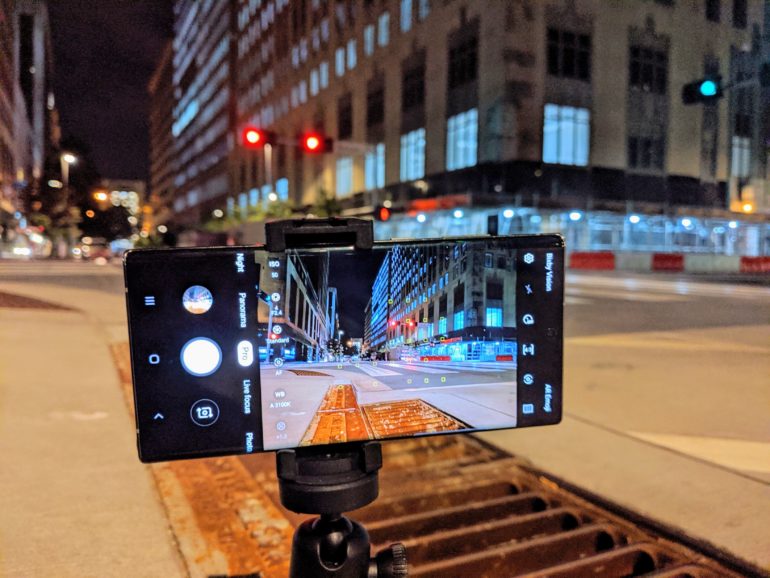
The Pro Mode is where things can get a little confusing simply because the implementation of the manual controls is not well thought out. The icons for each setting are so small that it can be hard to read them on the fly. Everything you need is there, though. You’ll find ISO, shutter speed, aperture, white balance, and autofocus controls, which is really nice. Overall the camera is fun to use. You can whip the phone out of your pocket, quick launch the camera with a double-tap of the power button, and fire off shots quickly. If you want to take your time with things, you can use the Pro Mode to get exact exposure you want. For the everyday shooter who doesn’t want to carry around a dedicated camera, there will be few complaints.
Recommended Apps for Photographers
To get the most out of the phone, I would highly recommend downloading Lightroom Mobile. When you use the camera in Pro Mode, you can save both RAW and JPEG files. Lightroom recognizes the DNG files immediately, and being able to edit them on the go is great. The RAW files from the Samsung Galaxy Note 10+ are quite pliable too. You can push and pull them a fair amount. You’re not going to get the dynamic range of a larger sensor, but you can still alter white balance, pull some details out of the shadows, and recover a bit from highlights. Other apps such as Instagram and 500px will help you share your images quickly, and the Photographers Ephemeris and Photopills will help you plan your photoshoots. These are always my go-to photography apps.
Image Quality

You’re really not going to be disappointed with the image quality from the Samsung Galaxy Note 10+. I came away from my time with the device talking about just how much camera phones like Samsung’s are really starting to blur the line between compact cameras and smartphone cameras. I was able to get some excellent shots with the Note 10+. If you know what you’re doing and can utilize the Pro Mode, you will be seriously impressed. The cameras produce richly colored images, there’s little in the way of vignetting, and distortion is well controlled (even though it is a bit more evident on the ultra-wide lens).
Point and shoot photographers will be equally as impressed with the JPEGS the Note 10+ produces as well. I edited the RAW image above on the phone and then printed it on a Canon Pro-100 at 9×13, and it looked fantastic. I wouldn’t hesitate to print larger. For the sake of transparency, I will tell you that all but the long exposure images in these samples have been untouched. This way, you will be able to see the quality of the photos as they came from the phone, and you can judge them for yourselves.
AI in Use

The Samsung Galaxy Note 10+ does employ some artificial intelligence, and while it kind of works, it does have flaws. The AI focuses on helping to create buttery smooth backgrounds, or it tries to help make low light photography easier. I had mixed experiences with the AI on this phone. At times it appeared that the night mode made very little difference to some of my images, and you can only really use it if there is no movement in your scene. The AI, when it comes to portraiture and creating bokeh, can help produce some great results, but it can also get things very wrong.




There’s a long way to go when it comes to computational photography. For the most part, I did not use the effects offered because the results were inconsistent. Your mileage may vary if you decide to use these features. I just wish they were more consistent.
Portraiture

The AI can help with portraiture for sure, but just like the night mode, it can be inconsistent. You’ll find several effects that you can apply to your portraits. Portrait mode (which is called Live Focus for some reason) will allow you to apply blurry backgrounds, extra-large bokeh balls, swirly backgrounds, and more.

To be honest, most of the effects are gimmicky and look terrible. When these filters work, they look okay. When they don’t, the results are not great at all. You’ll find objects have holes in them, and parts of objects will be missing altogether (like in the image above). Sometimes your model’s face will be a blurry mess too.
Food Photography
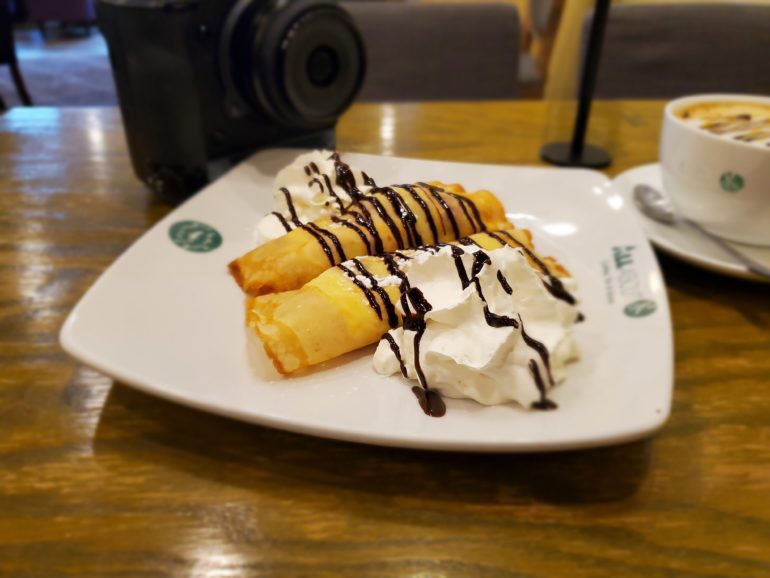
Ah yes. Food mode because that’s a thing now. The built-in Food mode will allow you to snap images of your nosh so that you can post it to Insta for the world to see. Basically, when you select this mode, you will get a small circle on the screen that you place over your plate. Once it’s in place, snap your picture, and a blurry bokeh effect will be applied.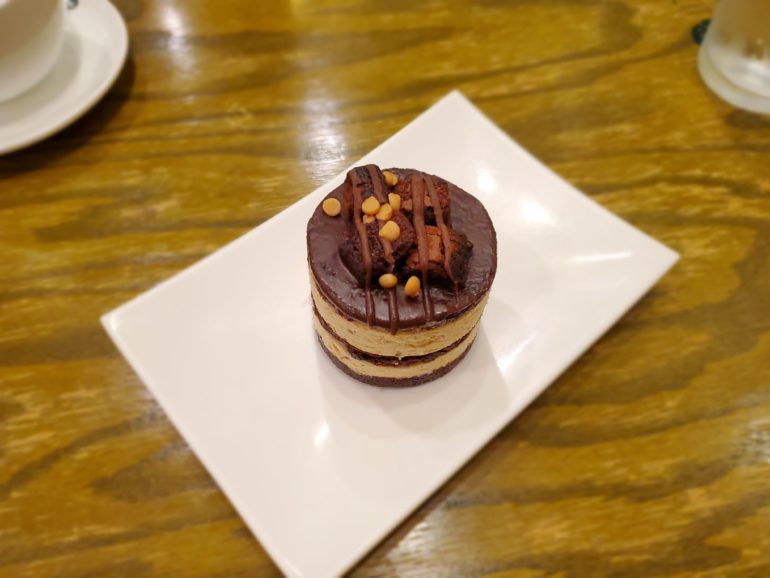
To be fair, food mode does a decent job. If you like taking pictures of the food you eat and you would like for it to really pop out of the image, you’ll likely enjoy this mode.
More Image Samples
Landscapes and Cityscapes





Parties and Events






Night Scenes
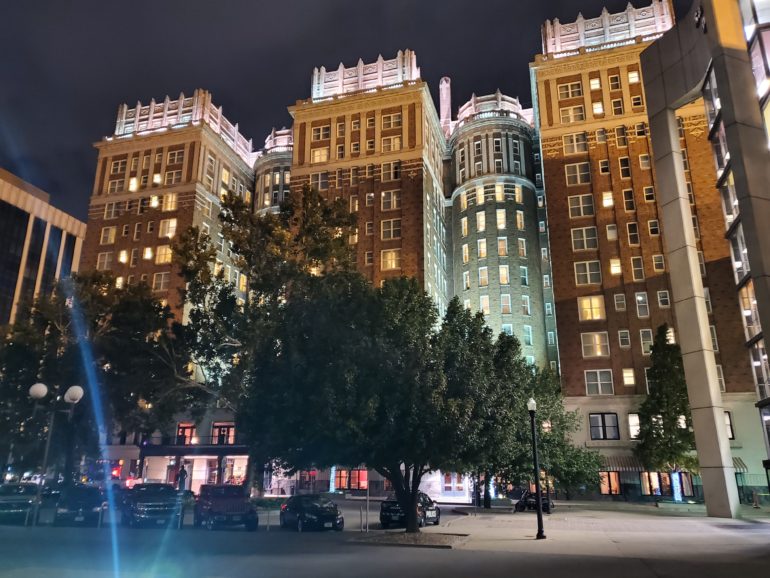


Ultra-Wide, Standard, and Telephoto Comparison



All three images above were taken while standing the same position. I simply switched between the three lenses using the on-screen controls. The three lenses offer great versatility, and it’s nice to have them as an option instead of having to rely on digital zooms.
Conclusions
Likes
- The three lenses offer great versatility
- The image quality is very impressive
- Great battery life
- Pro Mode will help you get the most out of the camera
Dislikes
- The AI modes are incredibly inconsistent
- While uisng the camera, the touch screen controls can be frustrating
- The Samsung Galaxy Note 10+ can be hard to hold while in use as a camera
Overall, the Samsung Galaxy Note 10+ is not only a great phone to use every day, but it’s also an excellent camera. Some design flaws make the camera a little hard to hold, but that can be fixed by using a case. The cameras are impressive, and you can get some great shots with some excellent dynamic range and sharpness. Can this phone replace a point and shoot camera or even a more dedicated compact camera like a Ricoh GR III? Honestly, it’s entirely possible. It all depends on what you plan on doing with your shots. If your images will only exist in the digital realms and you have no plans to print your pictures, then yes, the Samsung Galaxy Note 10+ will honestly be more than sufficient for most people. If you plan on printing large images frequently, you’re going to need a dedicated camera with a larger sensor.
If you like the idea of carrying less on your person, then the Galaxy Note 10+ will be an excellent option for you. For everyday shooting, the cameras do a great job in most situations, and they perform well for more specialized tasks like long exposures. Low light photography is still a nemesis for cameras with small sensors, and until massive improvements are made to AI-based night modes, this is where you’ll be less than pleased with the results. Looking at some of the images I was able to capture, I am shocked at just how far camera technology has progressed in mobile devices. If you’re looking for a new Android-based phone, and a good camera is a must, the Samsung Galaxy Note 10+ should be up there at the top of your list.

The Samsung Galaxy Note 10+ receives four out of five stars. If the camera was perhaps a little easier to handle, and the AI was more consistent, it would have received a perfect score. The carrier-unlocked model we tested with 256GB of storage space retails for $1,099.99.


